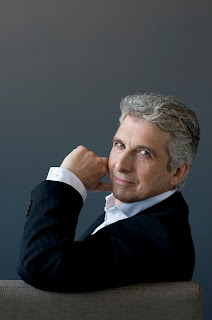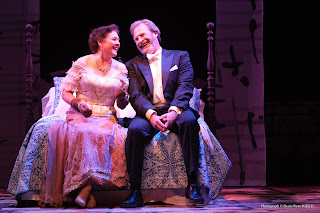Indianapolis Symphony Orchestra makes a long-delayed return to concert performance
Raymond Leppard, the late conductor laureate of the Indianapolis Symphony Orchestra, used to speak
from the stage of music the ISO was about "to play to you."
 |
| Guest conductor Peter Oundjian |
The phrase, a British usage among those the naturalized American citizen delightfully retained from his native England, seems particularly apt when considering the ISO's return to performing in front of an audience seated in its home hall, Hilbert Circle Theatre. "Play to you" emphasizes the directness of communication to be treasured especially now; it's as straightforward as "talk to you." The concert-giving norm can be glimpsed as the pandemic gradually comes under control. It's for us as well, of course, but seems especially to us as it resumes.
With guest conductor Peter Oundjian on the podium Thursday night, the ISO played to us actually (and virtually via livestream) for the first time since March 2020 — 429 days, by the reckoning of James Johnson, the orchestra's CEO, in remarks beforehand. So regrettable was such a long hiatus that I found pleasurable even orchestra members' conventional noodling and individualized warming up as socially distanced patrons took their seats. And when concertmaster Kevin Lin guided the tuning, it was almost balm to the ears.
The concert was dedicated to Christel DeHaan, a loyal patron of Indianapolis arts who died last year. Thursday's program was in pandemic trim, with no intermission, lasting under 90 minutes. Four works displayed the orchestra in mostly complete form, with two of them from the core repertoire: Beethoven's "Egmont" Overture and Mozart's Symphony No. 40 in G minor. In between came showcases for strings and winds: George Walker's "Lyric for Strings" and Richard Strauss' Serenade for 13 Winds, op. 7.
In normal times, the Strauss would have been presented from the front of the stage, where the ensemble could be fully visible. Fortunately, audibility was in no way compromised as the wind players performed with views from the main floor partially obstructed by their string colleagues, seated downstage and awaiting their turn to shine in the Walker piece.
Strauss was already channeling his father's profession as a horn player at the start of a long composing career that was to include an array of horn glories. The ISO contingent met the mark along with the nine woodwind players. The principal oboe leads a splendid phalanx of instrumentalists; in this pert performance that role was capably filled by Nathan Hughes, first oboist in the idled Metropolitan Opera Orchestra. He's among the teachers of Jennifer Christen, the ISO principal who's now on maternity leave. Until she returns, local oboists will be first-chair guests for several concerts.
Walker, an African-American master composer who died in 2018, wrote "Lyric for Strings" to honor his grandmother. It was most fitting to include in a concert with the memorial aspect of this one. The piece is tender and assertive by turns, perhaps representing facets of the composition's honoree. It unobtrusively highlights the different sections of the string choir, but the overall impression is of affectionate unity; I liked the way the final phrases were gently isolated to amount to a benediction.
Beethoven's "Egmont" Overture belongs to incidental music for a play by Johann Wolfgang von Goethe that pays respects to a hero of 16th-century resistance to Spanish tyranny in the Netherlands. Egmont was a nobleman torn between two versions of patriotism — strains on his loyalty and honesty that may distantly foreshadow struggles today to sort out conflicting obligations of patriotism in this country. The count, despite his devotion to the Spanish king, was executed for opposition to the repressive way Spain was governing his homeland.
Thursday's performance highlighted the stern atmosphere of foreboding at the start of the overture, then made much of the dramatic tension that Beethoven's interest in the subject drew from him at a high level of inspiration. Oundjian elicited from the orchestra a particularly suspenseful, very slow anticipation of the fiery, triumphant coda.
It's one of the great musical statements of victory over obstacles; in high school, I remember seeing at school a United Nations film that used the overture to highlight the world's problems of poverty and strife, yielding as the coda rushed forward to potential triumph over all the troubles. Ever since, I've found it impossible not to be stirred by this piece. In Thursday's context, the ISO adumbrated a different kind of victory, for which the pandemic-weary human community is no doubt hoping.
Mozart's G minor symphony is another universally acknowledged masterpiece. Its appeal to me among his late symphonies has worn thin over the years. The Canadian pianist Glenn Gould, whose challenging perspectives about music have been preserved in interviews, essays and radio broadcasts, judged the piece worth nothing more remarkable than that amazing fit of near-atonality just before the finale's development gets under way. My view is closer to the consensus. Still, the innovative murmur with which the work opens and the somewhat dogged treatment of the main theme ("It's a bird, it's a plane, no, it's Mozart") have lost their thrill.
Nonetheless, Thursday's performance featured a nice display in the second movement of the way a repeated two-note figure — sometimes going up, sometimes down —varies in expression from a nonchalance that is close to salon music to a tragic series of sighs. Mozart, the ace opera composer, thus comes through here in the emotional variety he was supremely capable of embodying within a unified work.
A botched horn re-entry was the only flaw in the Andante's performance; the horns made up for that in the hearty glow they lent to the minuet-and-trio third movement. The finale has that shocking bit Gould admired so, but it also, in this performance, brought to the fore the music's rhythmic nimbleness under Oundjian's direction. The violins sounded good, and flashes of contrapuntal mastery were most welcome as the performance moved toward an exhilarating conclusion.
As Mayor Joe Hogsett told the audience at the outset after being introduced by Johnson: "Our community has been at a crossroads, and we have chosen the path of preservation that leads to character." * Those words are a good enough seal to put on the ISO's welcome return to the concert stage. A different classical program might well confirm that impression in Saturday's "Spring Inspirations" concert.
*Maybe those words were "a good enough seal" because they appear to have been borrowed by the mayor from lines spoken by Al Pacino in the film "Scent of a Woman," according to a May 26 IndyStar story by Amelia Pak-Harvey (no relation).
[Photo by Sian Richards]


Comments
Post a Comment